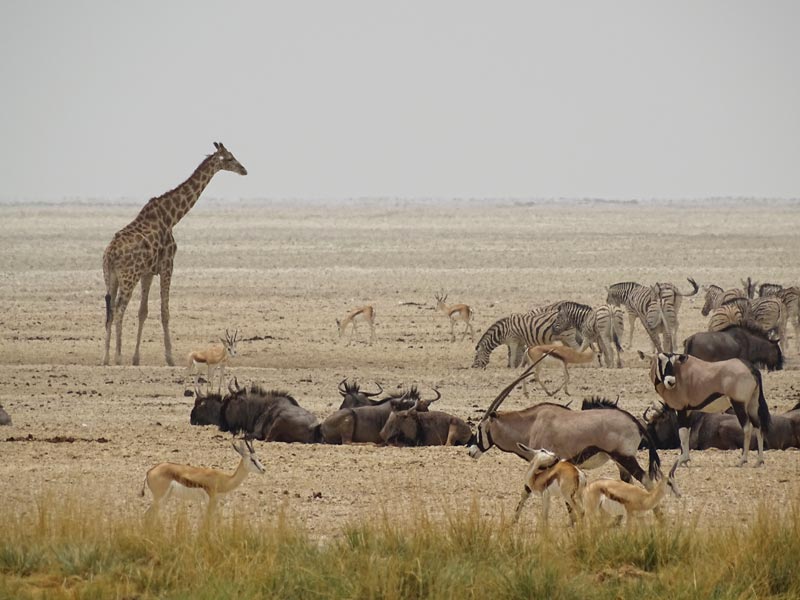
An ostrich with her babies.
Writing and photography by our man in Africa, Howie Minsky
It was last December when I said I want to live more deeply. I found myself distracted, living for work and for others. I found myself being pulled in too many directions, none of which made me happy or fulfilled. I was no longer living life; I was just existing. I felt if I didn’t take a stand to take back my life, when would I?
At the time, I was not sure what to do, but I decided to take the time to discover an outlet for my true passions. It was Jan. 10 when I spoke to an acquaintance who told me how she worked with meerkats in South Africa for 45 days each year. I was dumbstruck. It sounded like the coolest thing I had heard in a long time. I thought surely she must work for a university or be a wildlife specialist. Instead, she told me these opportunities are available to anyone. There are several very reputable organizations offering volunteer opportunities around the world to work with wildlife conservation, teach English abroad, or work with the elderly or infirm.
After I picked my jaw up off the floor I rushed home to research volunteer opportunities. Two days later I was booked on my first international trip to volunteer for 30 days on a big game preserve in Victoria Falls, Zimbabwe.
It was an experience that changed my life.

A bull elephant ready to charge.
While in Vic Falls, each day seemed better than the last. I helped fix water holes and fences, I dug trenches to prevent erosion during the rainy season, planted trees, and did maintenance on a one-room schoolhouse far out in the bush. Every day was a new learning experience about wildlife, its habitat and me. It was one thing to watch TV or read about an elephant and quite another to end up 15 feet away from a 15,000-pound bull elephant in musth preparing to charge.
Each day on game drives we’d see rhinos, giraffes, elephants, lions, Cape buffalos, zebras and dozens of bird species all colors of the rainbow. We would search for specific animal species to count them, determine their approximate ages, what they were eating, their overall health and their locations on the preserve.

Beside the waterhole, giraffe, zebra, wildebeast and springbok graze and rest.
When it came time to leave after 30 days, I felt like a part of me was being left behind. One volunteer here said it best, quoting Dr. Seuss: “Don’t be sad because it’s over, smile because it happened.” I returned home to South Florida and I was surprised to find Africa returned with me. I soon began sharing my adventures and giving talks about wildlife conservation at elementary schools in the area. I also applied and was accepted as a volunteer at Lion Country Safari in West Palm Beach, where I continued to be close to the wildlife I had become ever more interested in.
Specifically, I began observing chimpanzee behavior for ChimpanZoo, a Jane Goodall Institute. Of the 17 chimpanzees, I was amazed to find each chimp had his or her own distinct personality. To this day, I try to be objective, but find myself having favorites. Of all the chimps, Melody is my favorite. She is one of the best surrogate mothers to other chimps in the program and because there are currently no small chimps to mother, she has commandeered a jacket from one of the keepers and wears it as if it were a baby chimp. At all times. When she takes a dip in the lake, she gently rests the jacket on the grass, slips into the water and then retrieves her jacket when exiting the water. Of course she is still a wild animal, but she’s my kind of girl.
I have since returned to Africa and am currently in a 4×4 touring the national parks of Namibia, Botswana, and Zimbabwe on my own. I have been exploring Etosha National Park in Namibia, part of the inland sea that was Africa 50 million years ago. The coral reefs that made up northern Namibia have become the white limestone sand and grasslands on which herds of elephant, zebra, giraffe, wildebeest graze. There are great prides of lion, and the tiny dik-dik, the world’s smallest antelope. In all my travels, I have yet to view the leopard. It is the top of my list now on this trip.

This is a dik-dik, the smallest antelope in the world.
Still, even an adventurer in the African wild can end up in a car accident, as strange as that sounds. Yesterday while driving the B1 highway from Etosha to Mahango National Park in Divundu, Northern Namibia I was hit broadside on the passenger side. The 4×4 I was driving was totaled but the those in the other car and I walked away without so much as a scratch.
At the police station, where I was finalizing accident reports for the no-fault accident, the detective told me had this accident occurred on the other side of town I would have most likely been stoned to death by the locals. Seems even a fender bender involving outsiders would be subject to this local animosity. Guess I am luckier than I thought.
I am currently waiting for a replacement 4×4 to continue my quest to observe leopard in the wild.
As I wait, I realize how fortunate I am to have found my true passion in wildlife conservation. I hope I can spend the rest of my life educating those unaware of the beauty of our wild world—and the ever more important need to protect it before it’s gone.







